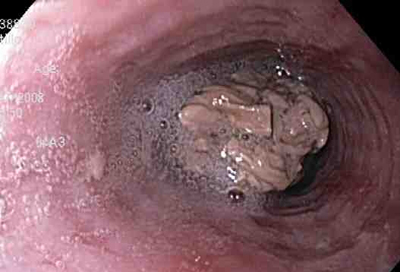Summary
Definition
History and exam
Key diagnostic factors
- presence of risk factors
- dysphagia
- non-specific abdominal pain
- stridor and wheezing
- drooling
Other diagnostic factors
- gagging, nausea/vomiting, neck/throat pain
- atypical chest pain or non-cardiac chest pain
- choking
- lower gastrointestinal bleeding
- pain on swallowing
- fever, poor feeding, failure to thrive, and irritability (in children)
- acute or chronic asthma-like symptoms or recurrent pneumonia
- signs of sepsis
- sign of acute drug intoxication
Risk factors
- age <15 years
- male sex (adults)
- gastrointestinal tract narrowing
- chemical dependence
- intellectual disability
- mental illness
- inmates or people engaged in criminal activities
- dental disorders
- hurried eating
- impaired gag reflex
- history of underlying oesophageal disease, surgery, or procedure
- seizure disorder
Diagnostic investigations
1st investigations to order
- x-rays of neck, chest, abdomen
- FBC
- basic metabolic panel
- prothrombin time (PT)/INR, PTT
- hand-held metal detector
Investigations to consider
- cardiac biomarkers and ECG
- CT of neck, chest, and/or abdomen
- MRI
- laryngoscopy
- endoscopy
Treatment algorithm
Contributors
Authors
Brian M. Fung, MD
Gastroenterology Fellow
Division of Gastroenterology and Hepatology
Department of Internal Medicine
University of Arizona College of Medicine - Phoenix
Phoenix
AZ
Disclosures
BMF is the author of one reference cited in this topic.
Acknowledgements
Dr Brian M. Fung and Dr James H. Tabibian would like to gratefully acknowledge Dr Andrew C. Meltzer, Dr Juan Carlos Munoz, and Professor Luis F. Laos, previous contributors to this topic.
Disclosures
ACM, JCM, and LFL declare that they have no competing interests.
Peer reviewers
Prakash Adhikari, MBBS, MS
Consultant
Ganesh Man Singh Memorial Academy of ENT and Head and Neck Studies
TU Teaching Hospital
Maharajgunj
Kathmandu
Nepal
Disclosures
PA declares that he has no competing interests.
Jose Fernando Aycinena, MD
General Surgery Chief Resident
Department of General Surgery
University of Tennessee Medical Center
Knoxville
TN
Disclosures
JFA declares that he has no competing interests.
Richard V. Schaller, Jr, MD
Clinical Research Fellow
Cleveland Clinic Florida
Weston
FL
Disclosures
RVS declares that he has no competing interests.
David J. Hackam, MD, PhD
Associate Professor of Pediatric Surgery
University of Pittsburgh School of Medicine
Pittsburgh
PA
Disclosures
DJH declares that he has no competing interests.
Peer reviewer acknowledgements
BMJ Best Practice topics are updated on a rolling basis in line with developments in evidence and guidance. The peer reviewers listed here have reviewed the content at least once during the history of the topic.
Disclosures
Peer reviewer affiliations and disclosures pertain to the time of the review.
References
Key articles
Kramer RE, Lerner DG, Lin T, et al. Management of ingested foreign bodies in children: a clinical report of the NASPGHAN Endoscopy Committee. J Pediatr Gastroenterol Nutr. 2015 Apr;60(4):562-74.Full text Abstract
Gracia C, Frey CF, Bodai BI. Diagnosis and management of ingested foreign bodies: a ten-year experience. Ann Emerg Med. 1984 Jan;13(1):30-4. Abstract
Wai Pak M, Chung Lee W, Kwok Fung H, et al. A prospective study of foreign-body ingestion in 311 children. Int J Pediatr Otorhinolaryngol. 2001 Apr 6;58(1):37-45. Abstract
Thabet MH, Basha WM, Askar S. Button battery foreign bodies in children: hazards, management, and recommendations. Biomed Res Int. 2013;2013:846091.Full text Abstract
Ghahremani GG. Foreign bodies of the alimentary tract. In: Gore RM, Levine MS, Laufer I, eds. Textbook of gastrointestinal radiology. Philadelphia, PA: WB Saunders; 1994:2547-58.
Ikenberry SO, Jue TL, Anderson MA, et al; ASGE Standards of Practice Committee. Management of ingested foreign bodies and food impactions. Gastrointest Endosc. 2011 Jun;73(6):1085-91.Full text Abstract
Reference articles
A full list of sources referenced in this topic is available here.
Use of this content is subject to our disclaimer
